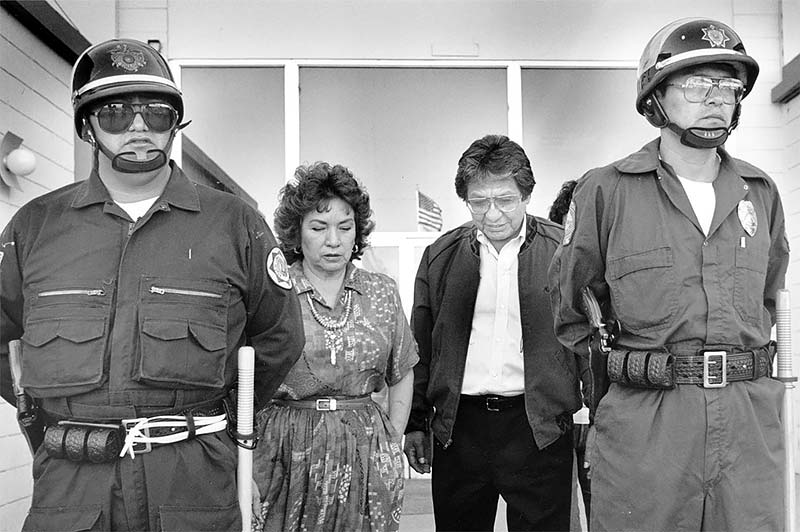
50 years ago: Bumper stickers Thorn in the side Of MacDonald

Navajo Times/Paul Natonabah Navajo Nation President Peter MacDonald (1970-1989) walks away from one of his hearings with his wife, Wanda, guarded by Navajo Nation police.

Navajo Times/Paul Natonabah
Navajo Nation President Peter MacDonald (1970-1989) walks away from one of his hearings with his wife, Wanda, guarded by Navajo Nation police.
In the 1980s, there was a major scandal when someone began printing bumper stickers with the question, “Who Shot PM?” The question referred to rumors that had been circulating at the time that Navajo Tribal Chairman Peter MacDonald was fooling around and that his wife caught him in the act and then took the law into her own hands.
Both MacDonalds over the years claimed that such a situation never occurred but the rumor still comes up now and again, with some tribal officials saying they know for a fact where MacDonald was shot. In the rear end seems to be the top choice and as for the location, at MacDonald’s Phoenix home.
This is one of those stories that probably will never be proven but one thing is certain – that was not the first scandal involving Peter MacDonald and bumper stickers.
In September 1966, MacDonald made headlines not only in the Navajo Times but also in other local newspapers over allegations that he may have been using federal monies to print up bumper stickers promoting Navajo Tribal Chairman Raymond Nakai in his ongoing effort to win re-election.
It turned out that MacDonald, who was then head of the Office of Navajo Economic Opportunity, had his offices in a building that also housed the tribal printing shop.
The whole matter came up when a reporter for the Navajo Times and others heard Sam Billison, who was running against Nakai, complaining about Nakai’s use of ONEO’s printing presses to make his bumper stickers and questioned if federal laws were being broken by using federal funds for such personal political gain.
Charley Toledo, a candidate for council delegate for Torreon, then decided to do his own investigation.
He said he went into he ONEO building about 10:30 a.m. and discovered four Navajos producing the bumper stickers using a silkscreen process. He also said he saw several cartons of paper and many completed stickers on tables.
He reported it to tribal police who decided to investigate and when they did later that day, they discovered most of the paper gone but they also found ink that hadn’t dried still on the tables.
The discovery that MacDonald was using federal funds for such a political purpose could have ended MacDonald’s career right then.
But here’s what happened.
When law enforcement investigators questioned MacDonald, he pointed out that while this was referred to as the ONEO headquarters, the program shared the building with the tribe.
While 20 to 30 employees of ONEO had offices in the building, the federal program only occupied at most one quarter of the office space in the building, and the tribe used the rest.
As for the printing operation, he said ONEO had nothing to do with it – that was operated by the tribe.
So the police investigation then shifted to the tribe and investigators learned that the printing operation was meant to provide a cheaper and more economical way for tribal departments to get their printing needs met.
And when the department had time, they could take commercial or non-tribal jobs and that is just what happened in this case.
The department had invoices and paperwork showing that Nakai had paid the printing shop to make the bumper stickers and there was nothing illegal about that.
So after about two days, Al Adams, the superintendent of police for the tribe, announced that his investigation was closed and no wrongdoing was found.
In other news, back in 1961, residents of Thoreau were promised that a new high school would be up and running before school started in 1962.
By the start of the school year, the new high school still had not been completed.
So parents held a town meeting and asked members of the Gallup-McKinley County School District what the holdup was.
The school board for the district, of course, found someone else to blame – the architecture firm of Kruger, Lake, and Henderson. The firm came under severe criticism for the delay of the construction of not only Thoreau High School but the Indian Hills Elementary School as well.
So at the town hall meeting the representative of Kruger, Lake, and Henderson, Mr. N. J. Kruger himself, told the crowd of concerned parents that while the firm was getting all of the criticism, the fault actually should be placed on the contractor.
“He was shut down for two or three months, we get the runaround and blame but, we’re not at fault,” he said.
The contractor pointed out that the delay was caused by the inability of the district to prove that the school would have an adequate amount of water when it opens.
A contract to drill a new water well for use by the school was scheduled to be let later in September or October of that year.
W.B. Fitzsimmons, superintendent of the district at the time, said he wanted the building completed by Aug. 15, 1967 “so that we’ll have time to move in before school starts.”
He proposed that the contractor be penalized $100 a day for every day the completion of the building was delayed beyond Aug. 15. He also proposed that the contractor get a $100 a day bonus for every day it was competed before Aug. 15.
The board did not go along with the proposal but they did pass a resolution saying they had confidence that the contractor would do what he could to make the Aug. 15 deadline.








 Highway 264,
Highway 264, I-40, WB @ Winslow
I-40, WB @ Winslow